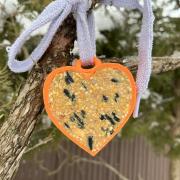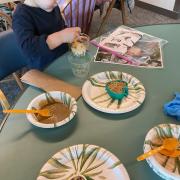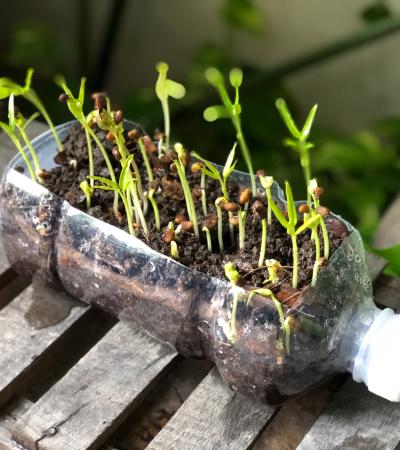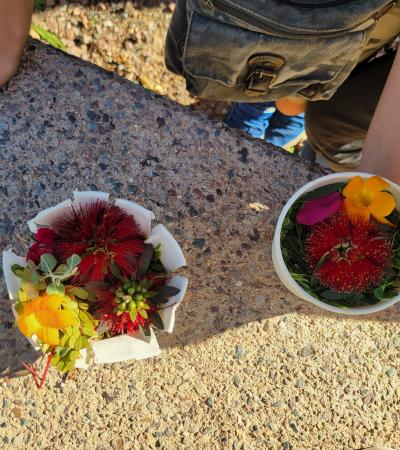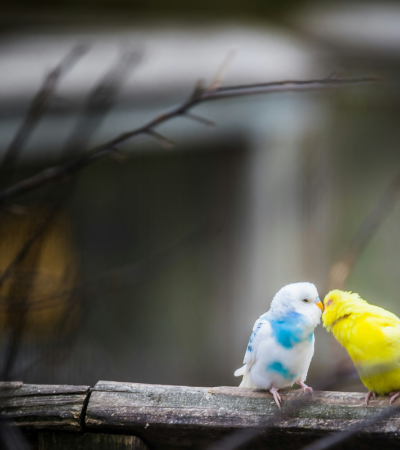This program combines hands-on crafting with nature education. Participants learn about backyard birds and create heart-shaped suet bird feeders using 3D-printed forms, bird seed, nut butter, grains and lard. Each participant took home two suet bird feeders and a handout about common species the feeders might attract.
Advanced Planning
The program goals were to:
- Educate library patrons about backyard birds and what foods they eat.
- Spark curiosity and appreciation for the natural world.
- Encourage continued engagement with backyard birds by creating something participants could take home with them, refill and reuse.
- Promote library services, including the 3D printer and bird feeder station.
The program took a couple of weeks to come together. The supplies for the suet feeders (bird seed, quick oats, cornmeal, lard, nut butter) were ordered online. Our technology coordinator printed the forms on our 3D printer. We went heart-shaped because the event was on Valentine’s Day, but any open shape can work. If you would like the file to print the 3D form, please email me (alusty@montauklibrary[dot]org). The forms were scaled to 3 ½ inches. We wanted a peanut-free program and it took some time to find a local bird seed variety that did not contain peanuts.
Before the event, I determined the ratio of suet supplies needed to fill the 3D-printed form. I created a handout that included the suet recipe and images of eight local species the feeders might attract. I also researched different suet recipes, the history of bird feeding, and what our local birds eat.
Marketing
The suet-feeder program was part of a Bird Lovers Weekend at the library. On Friday, we held the bird-feeder crafternoon, and on Saturday, we hosted a beginner birdwatching event coinciding with the Great Backyard Bird Count. The events were promoted together. Marketing materials and handouts were created using Canva.
We started the promotion two weeks before the events. A description and program flyer were shared with our local newspapers and local online calendar listings (press and local chamber of commerce). Patrons could register for the events on Eventbrite. Printed flyers were hung around the library. We promoted the program in our weekly digest emails and on Facebook and Instagram (two weeks before the event and again the week of).
This was marketed as an all-ages program with a mix of families with children and adults. Advance sign-ups for the suet feeder program sold out for our 20-person capacity.
Budgeting
We spent roughly $50 on new supplies for the program and used some things we had on hand from other programs. The below supplied enough materials for about 40 feeders.
Suet supplies: bird seed (6lb bag, $8.50); sunflower butter (16oz. $13); quick oats ($6); cornmeal ($3); and lard (2.5lb at $20 - MORE than enough for the program—I would suggest ordering less).
Other supplies we ordered or had on hand included paper plates, paper bowls, gallon ziplock bags, twine, paper towels, disposable gloves, cups and plastic spoons (roughly $50 if purchased).
We didn’t factor in the costs of the 3D-printed forms because we had filament on hand. If you don’t have a 3D printer to create the forms, you can get creative with cookie cutters, cups, and/or cardboard. You just need a hollow form that is open on two sides and some way to hang it.
Day-of-event Activity
The setup included pre-measuring and dividing birdseed, cornmeal, and oats into cups. The portions of lard and nut butter were pre-measured in paper bowls and warmed on warming mats (they can also be warmed in the microwave or on a sunny windowsill to a workable texture).
Tables were set up so each patron had a paper plate (as their work surface), a pair of disposable gloves, a spoon and paper towels. The 3D printed forms were at the center of the table so participants could pick which color they wanted to fill. Each person received a gallon ziplock bag to take home their feeders and a handout that included the ingredient list, recipe and images of common feeder birds.
We had three staff members to run the program: one leader to present the information and demonstrate, and two support staff to hand out supplies and help participants.
Program Execution
Once all the patrons arrived, I introduced what we would do. I showed an example of the finished product and explained the ingredients we would be using. Then, I discussed the history of bird feeding and asked participants if they fed birds, what they fed them, what their favorite birds were, and where they planned to hang their feeders.
Then, I talked about what birds eat and why supplemental feeding during the winter is helpful for them. After this brief intro to contextualize the program, I demonstrated how to mix the materials and fill out the forms.
After the demonstration, we handed out the pre-measured dry ingredients and the warmed pre-measured wet ingredients. Participants mixed the wet into the dry ingredients and used the spoon and their gloved hands to fill the 3D-printed forms.
Mixing the ingredients and filling out the forms only took about 5 minutes, so we invited participants to make a second one to take home. The finished products were kept on the paper plate and put in a gallon ziplock bag to take home. Participants needed to freeze the suet for 1-2 hours before placing it outside.
Ingredients:
- 1/4 cup wild bird seed mix
- 1 tbsp quick oats
- 1 tbsp cornmeal
- 2 tbsp lard or vegetable shortening
- 1 tbsp nut butter
Directions:
Mix dry ingredients (seed, oats, cornmeal) in a bowl. Warm the lard and nut butter, mix, and pour into the dry ingredients. Fill the feeder mold, then place it in the freezer for 1-2 hours to harden.
We had 19 participants for this event.
Advice
I recommend pre-measuring the ingredients and handing them out until after the demonstration so folks don’t get started on their own. Suet does best in temperatures below 50 degrees. This is a good wintertime or early spring program. The actual mixing of the ingredients doesn’t take very long. If you want to stretch the program to 45 minutes, I would recommend finding some other activities to fill the time. This also makes a great grab-and-go kit.
Supporting Materials
- Feedback (Coming Soon!)
- Programming Librarian Facebook Group

